
Alaska
20,310 feet 6,190 meters
|
 |
Denali - 2011 Alaska 20,310 feet 6,190 meters |
|||||||||
|
||||||||||
Alan Arnette is an
Alzheimer's advocate for individuals, their families and anyone impacted
by this disease through his professional
speaking, climbing and website.
His objectives for the Memories are Everything® climbs
are:
|
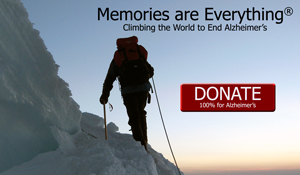 • NO
CURE, always Fatal • NO
CURE, always Fatal • No easy, inexpensive method of early detection • 3rd leading cause of death in the US • New case every 68 seconds, 4 seconds worldwide • Impacts more than 5+m in US, 25m+ worldwide • Devastating financial burden on families • Depression higher for caregivers • Issues are increasing rapidly as population ages |
Denali 2011: Failure or Non-Summit?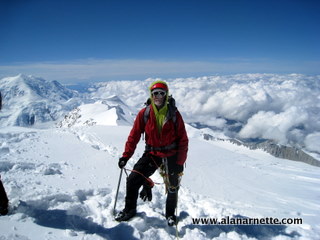
When I started to leave the 17,200 High Camp on Denali without standing on the summit, I wondered; how would people consider this effort. One person characterized it this way: “Alan, sorry to hear of the failure, but safety first. Safe travels home.” After spending eight days watching the swirling hurricane-force winds on the summit; it was safety first. We never got an opportunity to try to summit. It would have been difficult at best most of the time. Denali, well known for some of the harshest weather for climbers, had shown her stuff. Of all my 7 Summits climbs, I knew this one (after Everest; which I had summited the previous month) was the most risky. I could control my preparation, my health but not the weather. So what was this effort: a failure or a “non-summit”? Well obviously for me it was not a failure. I believe that every person I reached with the message of hope, need and urgency around Alzheimer's is one person more than if I didn't try. I see a climb similar to research where not every effort results in achieving it's goal but it does lead to new learnings and that has immense value. Besides, not trying is simply not an option. The rest of this trip report departs from my usual first person format as I did for my 2001 and 2007 climbs as I cover this climb in a more structured format. Team and Guide Service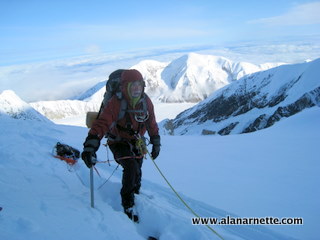
I climbed with Ophir, Colorado based Mountain Trip (MT). They are only one of six authorized commercial guide services for Denali. I did not have time so quickly after Everest to organize my own trip and also wanted to leverage the resources of a larger team in order to concentrate on my Alzheimer’s work. I had climbed with MT in 2001 and liked their casual style. I met with my teammates at the Earth Bed & Breakfast in Anchorage. We were a rather large (too large) team of 9 clients, 3 guides and an intern guide totaling 13 people. One of the MT owners, Bill Allen, drove us in the MT van to Talkeetna where we spent the night after a weather delay and flew the next morning via the Talkeetna Air Taxi to the Kahiltna Glacier to start our climb.
Route and Camps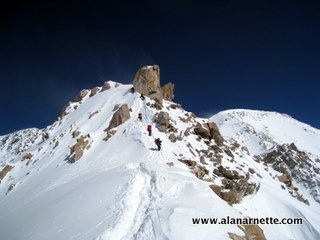
The US National Park Service (NPS) dictates much of how a commercial expedition is run on Denali thus leaving the guides with little flexibility. We followed the usual formula for a Denali West Buttress climb of making a series of camps from 7,200’ to 17,200’ ferrying food, fuel, personal and group gear to three caches along the way. We had camps at the normal spots of 7,200’, 7,800’, 11,000’, 14,200 and 17,200’. We traveled at night, in the Alaskan dim sunlight, along the frozen glaciers. The crevasses were in full bloom in early July. But our lead guide, Jared showed his expertise navigating deftly around them even under the shroud of dense fog. We had one weather delay at the 11,000’ camp but then started moving higher through Ski, Squirrel Hills then around Windy Corner to reach the 14,000’ Ranger Camp. We pulled sleds loaded with about 40 pounds of group and personal gear plus carried another 50 to 60 pounds in our backpacks. A normal Denali program. The mountain was not crowed this early July. We shared the route with a team from Alaska Mountaineering School (8). Another Mountain Trip (13) team plus one from RMI (8) followed us a day behind. Gear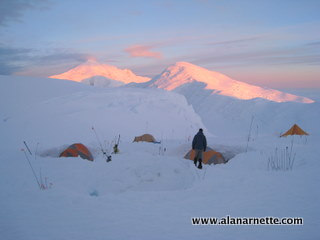
Normal cold weather and winter camping gear was used by all the team from merino wool base layers to lined shell pants. Jackets depended on weather conditions and ranged from light shells to full down. Glove systems were critical as were sunglasses and goggles. Boots were all over the place from double plastics to 8000m integrated gator versions. No one on our team suffered from extreme cold or frostbite. We stayed in 3 and 4 person Mountain Hardwear Trango tents. it was extremely crowded when we had 4 people in the tent. The food was cooked by the guides in the cook/dining tent dug into the snow. They used white gas and MSR XGK-EX stoves. Everyone moved in roped teams using chest harnesses, prussics for belaying and a jumar on the headwall.
Weather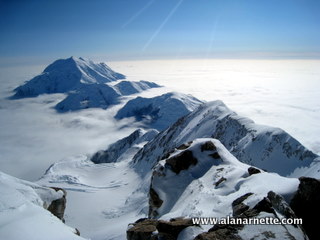
We experienced normal late June, early July Alaskan weather of relatively mild days with cold nights. If the night sky was clear, it was well below zero. During the day, if the sun was out, it was very hot especially inside the tents. The daily forecast was actually not far off from what we experienced but there enough doubt that the guides relied on their observations to make final decisions. Once we reached the 17K camp, the weather was mostly morning clouds with afternoon clearing but dominated by high winds on the summit ridges as evidenced by snow plumes visible from High Camp and 14 Camp.
Summit Bid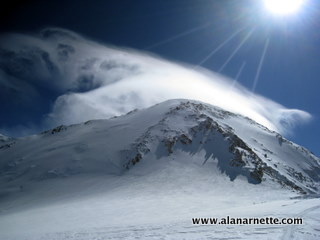
On Denali, everything is driven by the weather. Once we reached the 17,200 High Camp we hoped for a 16 hour window starting before noon to avoid the coldest temperatures of the early dawn. But for 7 straight days, it was “groundhog day” with identical conditions. We were greeted each morning with winds and low clouds, sometimes snow. After a simple breakfast we would while away the day napping, reading or taking short walks around the camp. By late afternoon, the skies would clear, winds drop and tease us that the next morning would be suitable for a summit attempt. There was one morning when the winds were low both at High Camp and on the ridge plus the forecast called for winds under 40 mph. But it would have required the team to push hard and fast. One disadvantage of a large commercial team is that the decision making tries to take into account everyone’s ability so if you have a wide range of skills or speed, some people will may not get what they want. When the forecast was issued two days before our schedule departure day, it was for three more days of high winds and heavy snow. In fact it snowed a foot and a half that night. We left the next morning. Retreat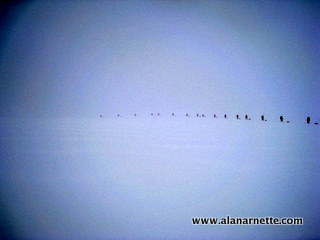
Our travel from High Camp to the air strip was not without some drama. It was near blizzard conditions causing us to bivy at the 11,000’ camp along with the other teams. Then once below Ski Hill, we stopped to pick up the RMI team and our large group of 50 climbers pulling sleds made the 12 hour trek across the Kahiltna Glacier, back up Motorcycle Hill. I was very impressed that Talkeetna Air Taxi made multiple flights to pick our team up late that same day.
Summary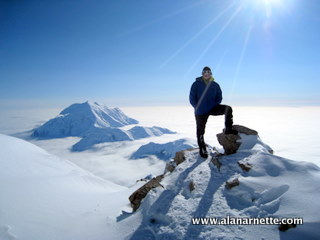
I was very disappointed not to have summited especially since I had made my previous summits of Vinson, Aconcagua and Everest the previous 6 months as part of my 7 Summits Climb for Alzheimer's: Memories are Everything® project. However, the weather simply did not cooperate and there is not much that could be done. We had a good team of clients and guides. Everyone got along well and the trip was well run. My only concern was that at times the trip felt as if it catered to the lowest skills on the trip thus I might have had a chance if I had been with a more experienced team or leadership willing to push it a bit more. A final reflection is that Denali feels like it has lost the wild feeling I found back in 2001. Maybe it is due to my experience but more to the point, it felt like it was run as a formula, similar to Mt. Rainier or Mont Blanc where operators run climbers up and down the mountain. About 1000 to 1500 climbers attempt Denali each year with an overall success rate of 50%, less for a non-commercial team. So I am behind the odds with 0 summits out of 3 attempts. Denali, you owe me one! However, beyond all the climbing, my 7 Summits effort is about Alzheimer's awareness and fundraising; not summits. I asked people to pledge a penny a foot for every foot I climbed or $119 for Denali. I was 3,000’ short making it $89 but everyone made the full pledge as if I had summited - so Denali is a summit for me! Climb On! |
The Alzheimer's Immunotherapy Program of Janssen Alzheimer Immunotherapy
and Pfizer Inc. funded my climbs for the 7 Summits campaign and ongoing efforts
between November 2010 and November 2012. All money I raised then and now from
donations goes directly to the organizations I have selected. During the campaign,
content posted here was my own but subject to certain limitations in conjunction
with the support of the AIP.
|
|